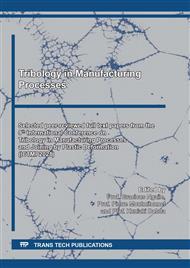p.117
p.125
p.133
p.139
p.147
p.155
p.163
p.169
p.179
Optimization of the Steady Combined Forward and Backward Extrusion Test for Higher Sensitivity to Friction in Cold Forging
Abstract:
To improve the sensitivity of the steady combined forward and backward extrusion test proposed in previous work, an optimization job based on the finite element simulations was carried out. A raw material of 0.45% carbon steel was tested under different stain rates from 0.001s-1 to 1s-1 and different temperatures from 30°C to 400°C, and the material flow stresses were modelled by Hensel-Spittel equation. The deformation degree of the forward extrusion was set as 50%. The key parameters including the deformation degree of the backward extrusion, the ratio between the radius of the punch nose and the radius of the punch, the taper angle of the punch, the die angle, the sizing lands of the punch and the die were optimized. The sensitivity of the optimal design is improved about 20% compared with previous design when the friction factor is assumed as 0.03~0.15. The new group of calibration curves presents more scatter than the old group. The sensitivity improvement is also validated by the experimental works.
Info:
Periodical:
Pages:
147-153
Citation:
Online since:
February 2022
Authors:
Keywords:
Price:
Сopyright:
© 2022 Trans Tech Publications Ltd. All Rights Reserved
Share:
Citation:


